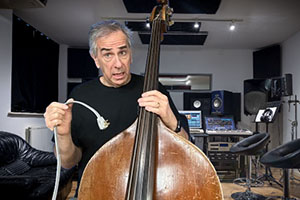While the purists complain, those who embrace technology are making music – and being heard
By Jon Liebman
February 23, 2024
Have you ever gone to see a traditional symphony orchestra perform and noticed that all the bass players had pickups on their basses? No way. And it’s a pretty safe bet you never will.
You see it all the time in jazz, but that’s a different culture.
And, believe it or not, there are still people out there who refuse to even recognize the electric bass as a legitimate musical instrument. (See my blog on Teymur Phell, about playing jazz on a bass guitar.)
In most cases, the goal is just to make the bass audible alongside the drums, horns, etc. The sound doesn’t necessarily need to be altered or processed.
And that goes for bluegrass too. Or at least it should. I see no reason why you can’t put a pickup on your bass when playing that style. The objective, after all, is the same — making sure people can hear the bass.
If you’re going to be a purist, be a reasonable one
The other day, I was having a very enjoyable conversation with Wayne Brewer, a 6th generation Kentucky bluegrass bass player, for this week’s FBPO interview. Over the years, Wayne has encountered a lot of people who are very passionate about not modifying the sanctity of the bluegrass genre. And that includes not tinkering with the natural sound of the upright bass.
“It’s a touchy situation,” Wayne says, “with bluegrass especially, because everybody’s so purist. They’re real traditionalist and all that. It’s almost like it’s sacred or whatever.”
Why is that? The sole purpose of amplifying an upright bass, as we’ve established, is so people can hear it.
“There’s always been a lot of kindly back and forth of what is and what’s not acceptable,” says Wayne.
Playing live versus in the studio
The good news, according to Wayne, is that the problem doesn’t exist during in-studio recording sessions, where his prized Kay upright can be miked and mixed to his liking. The issue is in live performances, where the sound is nearly always unacceptable.
For some reason, though, it doesn’t seem to bother the old-timers, who take the inferior sound as a given.
“You know, I’m younger,” Wayne says, “and I’m like, man, you know, this is a great bass, the Kay, but it sounds like crap on the PA because it’s just thumping. You know, it’s about like a fart. And you got the rattling going on and I’m like, man I just don’t like this.”
Do you think there’s a better way? There is!
Wayne knew there had to be a better way. He recalls explaining the situation to his dad, founder of the family band, Gary Brewer & the Kentucky Ramblers, hoping to find a solution.
Gary’s response? “He’s like, ‘Well, basically it’s been like that for, you know, all these years, ever since they invented bluegrass, pretty much.’ In other words, sort of if it ain’t broke don’t fix it.”
Frustrated, Wayne kept at it the old way for a couple more years. It wasn’t till the band started playing large festivals with other acts on the bill that he could see what other bass players were doing to avoid the problem.
“As I’m performing and going around the country and playing,” Wayne says, “you see these other setups that these other people have on the bass and pickups and all this and I’m like, man, that sounds traditional and it sounds natural to the bass. It sounds like a million bucks!”
Embracing the change
Eventually, with his father’s blessing, Wayne started experimenting with using pickups on his bass. The band also began making use of some of the newer technologies in their live performances, which made him a lot happier.
“Things have really come a long way since then,” Wayne says. “And now we all use the in in-ear monitors and that makes a world of difference because you can crank things louder not have all the frequency issues.”
Let the purists be. There’s music to be made – and heard.
The purists still exist, but Wayne, for the most part, is able to shrug them off. And don’t even mention an electric bass to these folks!
“Never an electric bass is allowed,” Wayne says of the bluegrass purists. “And then even upright basses like I had, like the Kay, no pickups on them. Everybody wanted the big thing for decades and decades and decades with the bass.”
Undeterred, Wayne continues to incorporate newer technologies in his rig. His bass arsenal now features several NS Design instruments, including an exquisite electric upright bass.
“Playing these uprights or an electric, that’s become almost sort of acceptable, depending on who you are” he says, laughing.
And as for his NS Design basses, “They sound like a million bucks,” he says, “without all of the garbage. You don’t have to put thousands of dollars of stuff on to make them sound that way.”
Nobody’s trying to detract from the genuineness of bluegrass. To me, it’s just common sense that all the instruments should be heard and they should sound good.
How about you?
What are your thoughts about putting a pickup on an upright bass, regardless of what style of music you’re playing? Leave a comment below and weigh in. And be sure to watch my interview with Wayne here.


Because jazz or acoustic music often tends to avoid extreme volumes, many Upright players go for a microphone snap-on. While there are good pickups out there, they often tend to lose something in the process in the body of the sound.
Everyone is entitled to their feelings on this. Practically speaking once you are playing with drums and horns and it’s not just in your living room then you really need some way to increase the bass volume in order sit properly in the mix. IF there are 2 or more horns you will be drowned out when they play together. So now you have to pick the compromise of either some sort of piezo-ish or a microphone that is strapped on somehow. I don’t think most people in the audience generally care as much as we bassist’s care and honestly I don’t think most band member care how you increase the volume as long as they can hear you. I think the main rule is to only use just enough amplfication as you need for the room. At lower amp volumes the piezo type of pickups don’t sound so bad. Once the volume get really loud you definitely loose much more the acoustic nuances of the instrument regardless of the pickup/mic system. Still, practically speaking, there is little choice in the matter and not using an amp makes no sense unless you don’t want to be heard. Anecdotally speaking I heard John Pattituci playing with a trio in theater with about 300 to 400 people. He had some sort of pickup system in his bass and a big stack of Genzler acoustic array speaks. The sound from the entire group was the best I have ever heard in a venue that big. The sound person deserves a medal of honor for creating the perfect mix. The bass still sounded like an acoustic bass.
Good points, Mark. Yes, there’s definitely a lot of give and take. Finding the right balance can be a challenge. Thanks for weighing in!
I think the best answer would be:
1-Learn how to produce a sound capable to carry a band.
2- Work on controlling your right hand so that it doesn’t over play.
3- Find a mic and a pickup that works best for your bass.
4- Never let front of house take a direct line out from the pickup. ( I’ve had nightmares )
Last, don’t be afraid to pull the strings 😝😝
Thanks, Carlos. It looks like you speak from a lot of experience!